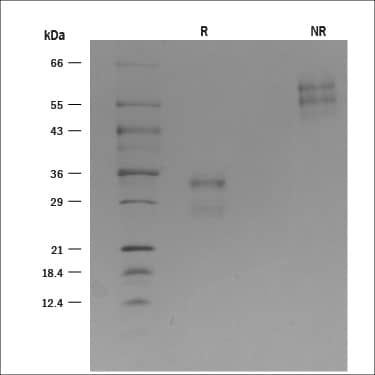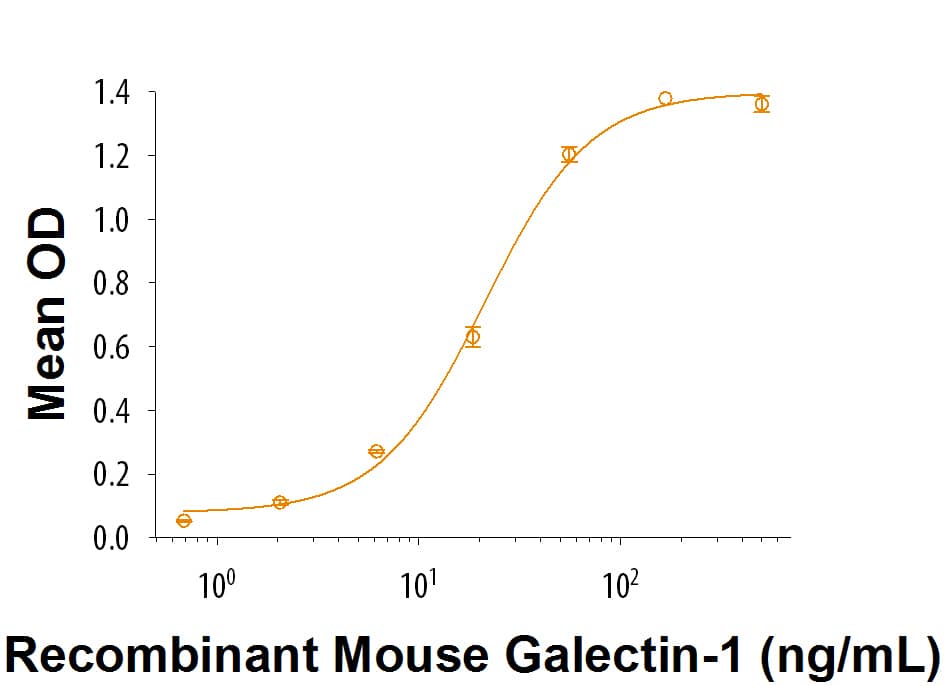Recombinant Mouse CD69 Protein, CF
R&D Systems, part of Bio-Techne | Catalog # 8469-CD

Key Product Details
Source
NS0
Accession #
Structure / Form
Disulfide-linked homodimer
Conjugate
Unconjugated
Applications
Bioactivity
Product Specifications
Source
Mouse myeloma cell line, NS0-derived mouse CD69 protein
Gly64-Arg199 with an N-terminal 9-His tag
Gly64-Arg199 with an N-terminal 9-His tag
Purity
>95%, by SDS-PAGE with silver staining.
Endotoxin Level
<0.10 EU per 1 μg of the protein by the LAL method.
N-terminal Sequence Analysis
His
Predicted Molecular Mass
17 kDa
SDS-PAGE
25-37 kDa, reducing conditions
Activity
Measured by its binding ability in a functional ELISA.
When Recombinant Mouse CD69 is coated at 1 µg/mL (100 µL/well), the concentration of Recombinant Mouse Galectin-1 (Catalog # 1245‑GA) that produces a 50% optimal binding response is typically 15-90 ng/mL.
When Recombinant Mouse CD69 is coated at 1 µg/mL (100 µL/well), the concentration of Recombinant Mouse Galectin-1 (Catalog # 1245‑GA) that produces a 50% optimal binding response is typically 15-90 ng/mL.
Scientific Data Images for Recombinant Mouse CD69 Protein, CF
Recombinant Mouse CD69 Protein Binding Activity
When Recombinant Mouse CD69 (Catalog # 8469-CD) is coated at 1 µg/mL (100 µL/well), Recombinant Mouse Galectin-1 (Catalog # 1245-GA) binds with an ED50 of 15-90 ng/mL.Recombinant Mouse CD69 Protein SDS-PAGE
1 μg/lane of Recombinant Mouse CD69 was resolved with SDS-PAGE under reducing (R) and non-reducing (NR) conditions and visualized by silver staining, showing R bands at 25 - 37 kDa and NR bands at 55-60 kDa.Formulation, Preparation and Storage
8469-CD
| Formulation | Lyophilized from a 0.2 μm filtered solution in PBS. |
| Reconstitution |
Reconstitute at 250 μg/mL in PBS.
|
| Shipping | The product is shipped at ambient temperature. Upon receipt, store it immediately at the temperature recommended below. |
| Stability & Storage | Use a manual defrost freezer and avoid repeated freeze-thaw cycles.
|
Background: CD69
References
- Gonzalez-Amaro, R. et al. (2013) Trends Mol. Med. 19:625.
- Ziegler, S.F. et al. (1993) Eur. J. Immunol. 23:1643.
- Hamann, J. et al. (1993) J. Immunol. 150:4920.
- Lopez-Cabrera, M. et al. (1993) J. Exp. Med. 178:537.
- Bieber, T. et al. (1992) J. Invest. Dermatol. 98:771.
- Alari-Pahissa, E. et al. (2012) J. Leukoc. Biol. 92:145.
- Lamana, A. et al. (2011) J. Invest. Dermatol. 131:1503.
- Radulovic, K. et al. (2012) J. Immunol. 188:2001.
- Shinoda, K. et al. (2012) Proc. Natl. Acad. Sci. USA 109:7409.
- Radulovic, K. et al. (2013) PLoS ONE 8:e65413.
- Hasegawa, A. et al. (2013) PLoS ONE 8:e65494.
- Shiow, L.R. et al. (2006) Nature 440:540.
- Martin, P. et al. (2010) J. Allergy Clin. Immunol. 126:355.
- Martin, P. et al. (2010) Mol. Cell. Biol. 30:4877.
- de la Fuente, H. et al. (2014) Mol. Cell. Biol. 34:2479.
- Cruz-Adalia, A. et al. (2010) Circulation 122:1396.
- Miki-Hosokawa, T. et al. (2009) J. Immunol. 183:8203.
Alternate Names
CD69, EA-1, Leu23, MLR-3, p60
Gene Symbol
CD69
UniProt
Additional CD69 Products
Product Documents for Recombinant Mouse CD69 Protein, CF
Product Specific Notices for Recombinant Mouse CD69 Protein, CF
For research use only
